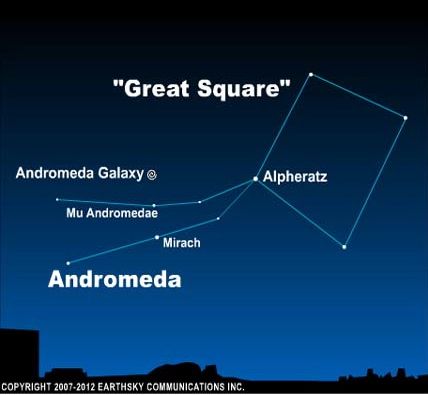 DEEP-SKY OBJECT OF THE MONTH- OCTOBER
DEEP-SKY OBJECT OF THE MONTH- OCTOBER
While the moon and various planets of our own solar system are, without doubt, fascinating objects for observation and study, it is the deep-sky objects that hold a very special allure for stargazers. Deep-sky objects are those things that lie beyond the realm of our own Sun and includes such things as star clusters, nebulae and galaxies. Some of them can actually be seen with just the naked eye but are best appreciated with binoculars or a telescope. This monthly feature presents you with a select deep-sky object that is worthy of your attention.
We will provide you with instructions on how to locate the featured deep-sky object but it is highly recommended that you also supplement the article with a planisphere or a star map (obtained either through an astronomy magazine or from the internet). Various apps and stargazing books will also be of value. Please see our list of resources found in the “Getting Started Stargazing” feature found here on our web site for further information
MESSIER 31, THE ANDROMEDA GALAXY (M31)
HOW TO FIND IT
It is highly recommended that you look for this deep-sky object on a moonless night and from a location that has dark to moderately dark skies.
 Locate The Great Square of Pegasus high up in the SE sky at around 9:00 or 10:00 PM. The Square of Pegasus is not a constellation in its own right, it is an unofficial pattern of stars known as an “asterism” and it represents the hindquarters of the famous flying horse, Pegasus (which is an official constellation). The Square is composed of four stars of roughly equal brightness and you might even try and picture it as baseball diamond rather than as a square.
Locate The Great Square of Pegasus high up in the SE sky at around 9:00 or 10:00 PM. The Square of Pegasus is not a constellation in its own right, it is an unofficial pattern of stars known as an “asterism” and it represents the hindquarters of the famous flying horse, Pegasus (which is an official constellation). The Square is composed of four stars of roughly equal brightness and you might even try and picture it as baseball diamond rather than as a square.
Let’s go with the baseball diamond analogy. Once you’ve located the diamond we can then designate the bottom most star as “first base”. Then go to the star that represents “third base”, this star is known as Alpheratz. Look closely and you will see a paired string of stars leading away from Alpheratz that trail back in an easterly direction. These stars represent the reclined form of Andromeda. (Don’t spend any time trying to see these star patterns as literal representations of the figures they are supposed to represent, just go with it.)
Going back to Alpheratz we will continue our journey with the bottom most string of stars. Heading east we will come to the second brightest star in this stream, Mirach. Looking above it to the top most string and we will see a somewhat fainter star known as Mu Andromedae. Let your eye roam up (north) from Mu Andromedae and you will find an even fainter star known as Nu Andromedae (binoculars will be your best friend here). Use your binoculars to drift a little way west of Nu and you will then see a smudge of light, this is the Andromeda Galaxy. If your sky is dark enough then you can see this fuzzy celestial cotton ball with your unaided eye.
 ABOUT THE ANDROMEDA GALAXY
ABOUT THE ANDROMEDA GALAXY
This is a great time to stop and point out something very important about observing deep-sky objects with a telescope: they are not going to look like those colorful glossy photos that you see in a magazine, book, or on the internet. The fault lies not in the stars my dear friend, but in your eyes. The human eye is just not big enough or sensitive enough to collect all the photons necessary to replicate the kind of image a camera lens can. On top of all this is the fact that M31 has a very low surface brightness (which is the overall brightness per a unit area), making it very dim to our eyes. The wonder factor in seeing an object like this comes from knowing what it is that you are looking at, and the more you know about something the more fascinating it will become.
That blob of fuzzy light is the nucleus of the Andromeda Galaxy. Think of it as downtown central of this vast city of stars. This fuzzy ball of light is the combined glow of millions upon millions of stars densely packed within the galactic core and lurking within them is a supermassive black hole containing, a gravity monster with a total mass equal to that of 100 million Suns.
The Andromeda Galaxy is a spiral galaxy, much like our own Milky Way Galaxy, but its spiral arms are too faint to be seen with backyard telescopes. If it were brighter, we would see the Andromeda Galaxy spanning an angular distance of 6 full moons lined up from end to end upon our sky! The reason that you are only seeing the nucleus of M31 in binoculars and telescopes is in fact due to it being so incredibly huge.
If you scan around with your telescope or binoculars you may also see two companion galaxies, Messier 32 and Messier 110. These companions have interacted with the Andromeda Galaxy over time and have distorted its spiral arms. In fact, M32 has probably already passed through the very heart of M31 once before and the dark dust that you see in photos of the Andromeda Galaxy may have been ripped away from the smaller galaxy by the much larger one.
In about 4 billion years’ time the Milky Way and the Andromeda Galaxy will collide together and merge as one REALLY big galaxy. Both galaxies will lose their spiral shape and will then become one huge, featureless, elliptical-shaped galaxy. Believe or not, the distances between the stars are so incredibly vast that the chances of any kind of stellar collisions are very slim. However, the supermassive black holes found in each galaxy will likely merge together to become one.
Your eye may not be as sensitive to light the way a camera or a large aperture telescope is but it still works pretty well under low light situations. It is worth stopping to consider that when you are looking at the Andromeda Galaxy, located some 2.5 million light years away (remember: one light year is the distance that light will travel in one year’s time, which is about 6 TRILLION miles!), that you are seeing the most distant object the human eye can resolve without any kind of optical aid.
It is also fun to speculate as to whether or not orbiting around one of those trillions of stars contained within the Andromeda Galaxy there might be a planet populated by a race of intelligent beings. Beings who have also made telescopes and are in fact looking back in our direction pondering the same thing. If they are then they are seeing our galaxy as it was 2.5 million years ago into the past, before modern humans even existed.